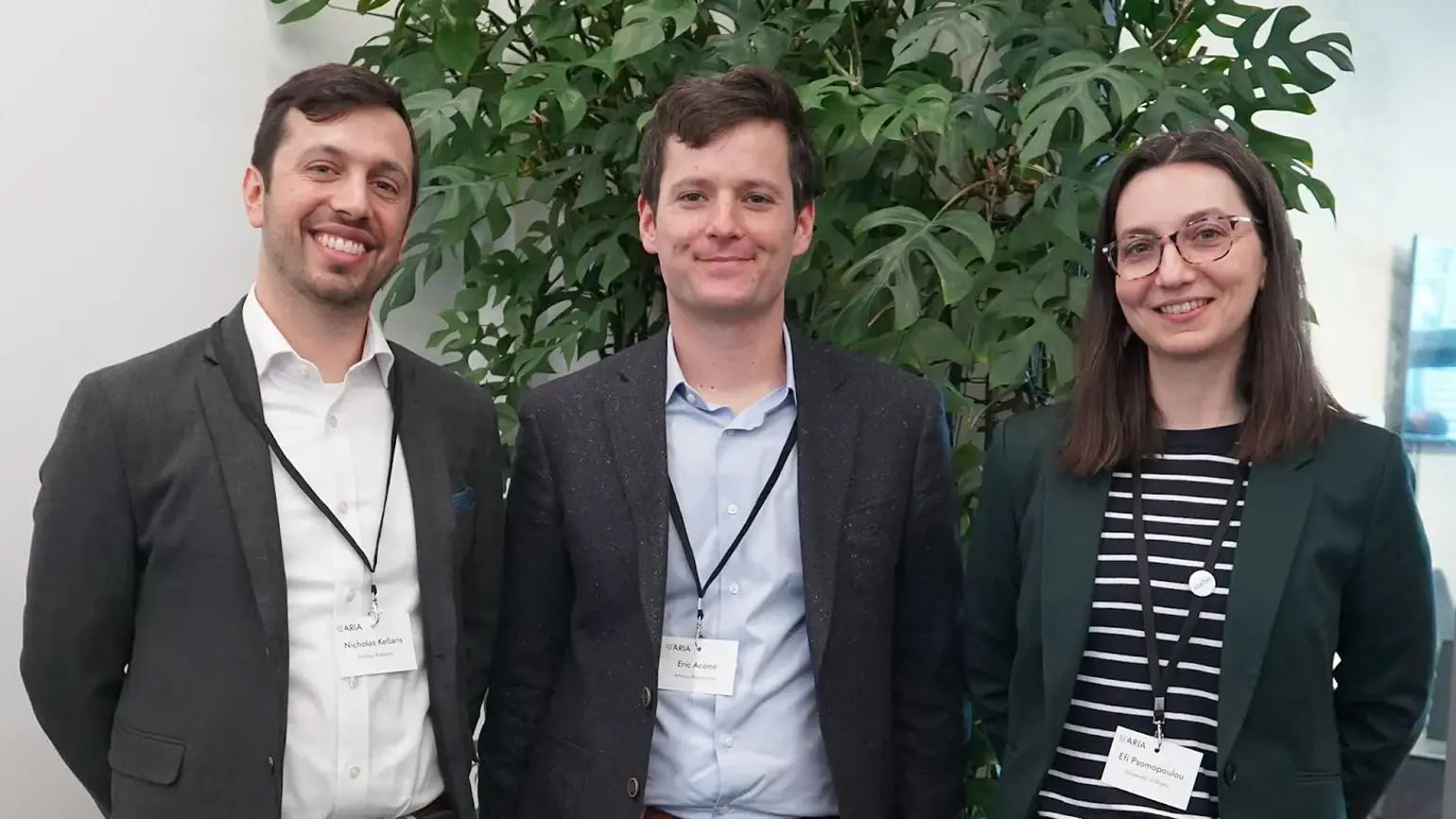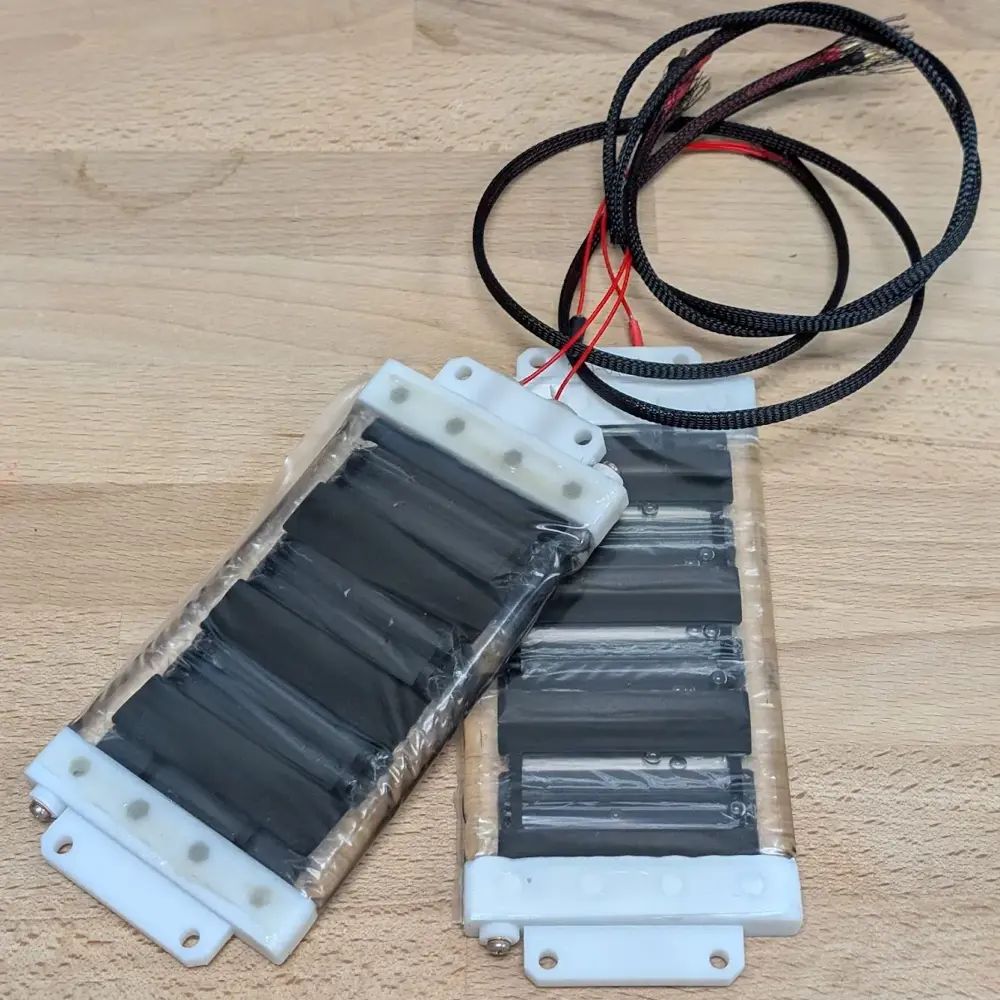29 August 2025
New material systems for HASEL actuators
As part of our Robot Dexterity programme, Creators Nick (Artimus Robotics, based in the US) and Efi (University of Bristol) are working together to build a high-performance, soft artificial hand with human-like dexterity. We recently caught up with them to find out how their cross-Atlantic collaboration is going.

Nick Kellaris (left) and Efi Psomopoulou (right) with Eric Acome (middle, Artimus CEO)
What are you currently working on?
Nick: We’re focused on new materials systems for our soft actuators (termed ‘HASEL actuators’) that will enable them to compete with biological muscle in key performance areas like actuation stress, strain, and speed. Our actuators operate using electrostatic principles, which means they store energy in the same way that capacitors do. And to support our collaboration with the University of Bristol, we’re also building a first prototype of a multi-finger hand using our actuator technology. The whole team meets biweekly for a conference call to update on progress, seek input, and plan next steps. In the future, we plan to have site visits to each other's facilities once we are working with more integrated hardware. It's been working well so far – in some ways it's nice to have such different time zones – like having two work shifts. Hand off information in the evening, and wake up to new results!
Efi: Yes, we met in person for the first time during the ARIA kick-off meeting – it was great to see the actuators developed by Artimus Robotics up close. We’re developing a high-fidelity digital model, a ‘digital twin’, of a custom robot finger powered by soft, voltage-driven artificial muscles. This simulation lets us explore how the finger bends, presses, and grips objects, before any hardware is built, so we can refine the design and understand real-world interactions. Because these muscles have a nonlinear response, the force they generate depends on both the applied voltage and how much they’ve already contracted. Right now, we're building our first controller to take advantage of that behaviour and move a single finger precisely and repeatably.
What early findings or signals are emerging from your work so far?
Efi: Translating a custom robot-finger design from CAD to a simulation-ready model proved more involved and more time-consuming than expected. While it can be done manually, the step-by-step conversions and parameter tweaks slow iteration. Automating this process would let us rapidly test and compare design variants. We’re working with ARIA’s Activation Partner, Amodo, to solve this.
Nick: To date, HASEL actuators have primarily been constructed from off-the-shelf materials that have been optimised for use in film capacitors. While these materials serve as a great jumping off point, we are seeing more and more that materials tailored specifically to the needs of our actuators have enormous potential to improve device performance.

Soft and touchable HASEL actuator stacks under development for integration with robotic manipulators
What do you wish more people knew about your research area?
Nick: I wish people were more familiar with electrostatic technologies in general! Electromagnetic technologies, like electric motors, are so ubiquitous that many folks don’t realise that there are other ways to achieve motion in a world that is moving towards electrification. Electromagnetic actuation uses high current running through wire to produce magnetic fields; electrostatic actuation, by contrast, uses the direct attractive force that positive and negative charges exert on each other. They don’t require rare-earth elements for high-performance magnets, there is essentially no heat generated during operation, and energy consumption during stall is nearly zero.
Efi: The most basic form of control for a system is a controller called PID, which is widely used in robotics and automation. It’s excellent for straightforward goals like holding a steady speed or position, but I wish more people knew it isn’t the only, or always the best, option. For more complex problems, such as a robot manipulating an object within its hand, the system behaves in nonlinear ways and the contacts are soft and deformable. In these situations, we need to use more advanced, nonlinear control methods that can handle changing conditions and tightly coupled effects. Developing and validating these controllers for robots with soft parts is an active area of research.
And finally, what book/film/tv show should people check out to understand your project or discipline more? Why?
Efi: I recommend Becky Chambers across the board, but especially ‘A Closed and Common Orbit’ if you care about robots and embodiment. It follows a former starship AI learning to live in a human-like body and to manage the awkward, fascinating business of having only two hands. The novel contrasts ship-wide, multi-sensor awareness with the narrow, tactile realities of a single body, offering sharp reflections on sensor fusion and why early motor skills (control) matter.
Nick: Big Hero 6... The movie's about a soft inflatable robot named Baymax, designed to be an at-home caregiver capable of safely interacting with humans – Baymax was actually inspired by researchers at Carnegie Mellon who are focused on the development of robots based on soft pneumatic systems.
